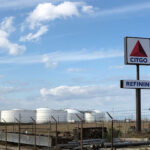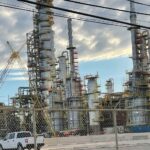WASHINGTON/NEW YORK – The U.S. oil industry saw nearly $200 billion in upstream deals last year, but the refining sector missed out despite plenty of willing sellers as the energy transition away from fossil fuels accelerates and casts doubt over the long-term value of aging U.S. refineries
The growing number of operators looking to sell assets reflects the hope that a post-pandemic surge in margins – which for some products nearly quadrupled in 2022 – might have opened up a rare window to exit assets profitably.
“Until very recently margins were fairly high and owners might have begun to fantasize that they could get a very good price,” said Garfield Miller, president of downstream-focused investment bank Aegis Energy Advisors.
Those fantasies, however, have not turned into reality.
Key industry metrics show plant valuations are down a third since the global financial crisis of 2008 and have not recovered, according to MorningStar analyst Allen Good.
A U.S. refinery has not changed hands since independent refiner Par Pacific PARR.N completed its $310 million acquisition of Exxon Mobil’s XOM.N63,000 barrels per day (bpd) Billings, Montana, plant last year. That deal came after years-long efforts by the oil major to sell the facility and closed at the lower end of the $300 million to $600 million range industry insiders were expecting.
Delta Air Lines DAL.Nhas made multiple failed attempts to offload the nearly 100-year old, 190,000-bpd Trainer, Pennsylvania, refinery since 2018 and is still trying, sources close to the refinery said, requesting anonymity as the discussions are private.
Phillips 66 PSX.N, the third largest independent U.S. refiner, is pursuing a $3 billion divestiture program that will likely include some of its smaller refineries, industry sources said.
Venezuelan-owned Citgo [RIC:RIC:PDVAC.UL] has three refineries in Texas, Louisiana and Illinois with combined capacity of 805,000 bpd up for sale as part of a U.S. court auction in a historic case to settle Venezuelan debts.
Top U.S. refiner Marathon MPC.N, however, in an October conference call indicated no interest in those plants, while rival PBF Energy PBF.N this week said it was not planning any deals in the near future.
Phillips 66 and Delta said they do not comment on market rumors or speculation.
ENERGY TRANSITION
The U.S. is the world’s top gasoline market and its refineries are mainly geared towards producing the motor fuel. Gasoline consumption, however, likely peaked in 2018 at over 9.3 million bpd and is expected to decline from next year onwards, according to government projections.
Refiners are expected to face new headwinds with the wider adoption of electric vehicles and policies intended to phase out fossil fuels.
West Coast refineries, which typically serve Californian and Latin American drivers, operate in a market where zero-emission vehicle sales are growing the fastest and state governments are accelerating the energy transition by banning sales of new gasoline-only vehicles by 2035.
Growing sales of electric vehicles in recent years have led forecasters to bring forward their projections for when global oil use will peak, as public subsidies and improved technology help lower prices for battery-powered cars.
Transportation is responsible for about 60% of world oil demand, with the U.S. alone accounting for around 12%, according to the International Energy Agency. That share should fall, as the IEA expects EVs to erase some 5 million bpd of world oil demand by 2030.
COSTLY MAINTENANCE
The rising cost of maintenance and workloads to keep aging plants online have also deterred potential refinery buyers, particularly as companies focus on shareholder returns.
Valero VLO.N, Marathon and Phillips 66 together had the equivalent of 280,000 bpd of capacity offline in 2023 due to planned and unplanned outages, a more than 20% increase from 2019, according to IIR Research.
For some operators, the bill to repair these facilities can be enormous. Phillips 66 spent $786 million on maintenance in 2023, according to company filings.
LyondellBasell’s LYB.N 260,000-bpd Houston refinery, which is scheduled to close next yearafter two failed attempts to sell, would have required about $1 billion in upgrades to continue operations, according to analyst and corporate estimates.
Shell SHEL.L has already closed its 240,000-bpd Convent, Louisiana, refinery, after failing to find a buyer during the pandemic. Seven other North American refineries have shuttered since capacity peaked at 19 million bpd in 2020, removing about 1 million bpd of capacity.
“Refiners are learning if they don’t invest in their facilities before they put their plants up for sale, interest will dwindle,” Aegis’ Miller said.
(Reporting by Laura Sanicola and Shariq Khan; Editing by Liz Hampton and Marguerita Choy)







